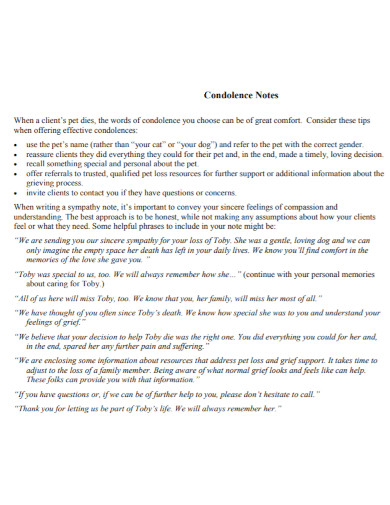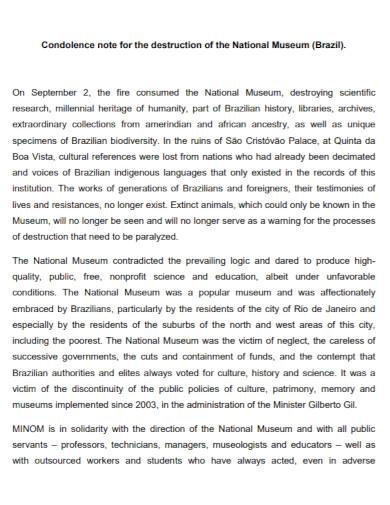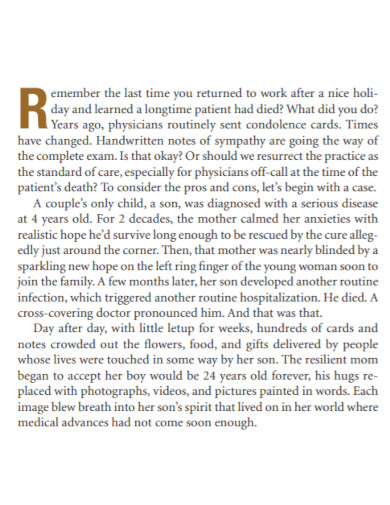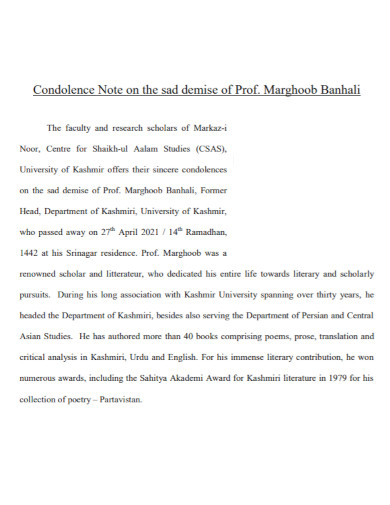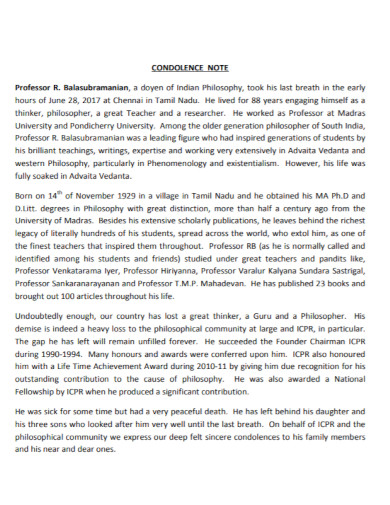7+ Condolence Note Examples to Download
It is not easy to have someone you know whether they are family or friends pass away so suddenly or have passed away. It is also not as easy for someone who may have experienced this quite recently, given the current issue that everyone may be facing as of late. But there are also some sympathetic ways we can send someone in time of their grief. A simple note to express your deepest sympathy over someone’s passing. Not to be confused with consoling the person. Rather you are simply showing that you understand. This is where the condolence notes would be used for. A condolence note is a simple message to show that you care for someone. If you are wondering as to what is the best message to write to show your sympathies, I suggest you scroll down and check out the whole article for more ideas.
7+ Condolence Note Examples
1. Child Condolence Note
2. Condolence Note Template
3. Standard Condolence Note
4. Doctors Condolence Note
5. Formal Condolence Note
6. Draft Condolence Note
7. General Condolence Note
8. Printable Condolence Note
What Is a Condolence Note?
A condolence note is a piece of formal paper that you write to express your deepest sympathies to someone. This kind of note is used by anyone who wishes to send their condolences to the people who have suffered a loss of a loved one. It can also be used as a way to notify people of the funeral. A condolence note’s message often differs as it depends on who the audience is to their messages. If you are sending it to someone who has lost a child, your sympathy message should also be about the child. If you are sending it to someone who lost a parent, it would be the same except your message has to be about the parent. A condolence note may come in different messages, but the main reason for having to send one is to express your grief, your sympathy and your personal message into one.
You may wonder what the whole purpose is to write a condolence note if it is easy to simply say the word instead. Of course a simple word of showing sympathy is fine, but having to send out a letter or a note to express would also mean a lot to the grieving family. It does not only mean you have them in your thoughts, but it also means that you understand how much it really means for them to have a simple note that states they care. Of course, another purpose of having to write a condolence note is to be able to give out a personal message. To be able to express what words cannot. However, you also have to be very careful with how you would be writing your condolence notes. There are ways on doing that too.
How to Write a Condolence Note?
You are probably wondering how do you write a good condolence note? Is there a format to writing one? Do you need to use a generic message to send to the family? These questions may be just some of the things you would be asking yourself when faced with the fact. How are you going to be able to write a condolence note if you have no idea? Here are some tips for you to read on and check out below.
1. Watch Your Tone
The first thing to consider when you write your condolence note is to check your tone. Your tone in writing should not be forced nor too general. This is important to remember especially if you are writing for a different kind of audience.
2. Match Your Message with the Age of Your Audience
If you are sending a condolence note to a child, match your message to the child’s age. Avoid using words that may be inappropriate for any kind of audience. Your purpose is to be sympathetic and not inappropriate.
3. Know the Name of the Deceased
It is not only proper but it is highly appreciated for them to know that you care enough to know the name of the deceased person. A proper way to write your condolence note is to address the name of the person in your message. To be able to do that, you must know the name early on.
4. Say Something Sympathetic
It is really okay to be sympathetic in your notes. It is highly expected to be sympathetic and understanding when you write your letter or your note. In addition to that, it is also appreciated by the family for your kind words during their time of pain. So show your sympathy, don’t be shy.
5. Be Honest and Professional
When you write your condolence note, remember to keep it professional. Avoid having to let them assume you are only making fun of them. Avoid having to let them think that you are only writing for the sake of writing. Be honest with how you feel about the news and as much as possible say something nice.
FAQs
What is a condolence note?
A note or a letter that you write stating your condolences. A note that you personally write to show your sympathy for the deceased.
Is it necessary to send a condolence note?
It is not a requirement to send one, but it is a good way to show that you keep the family in your thoughts.
Can I send a generic message?
A generic message is often something that is written for the sake of writing. It is always best to write how you feel to make it more personal.
It goes without saying having to lose someone is difficult enough. Having to send a simple and personal note may not be able to bring them back, but it is a good reminder for them to know that there are still some people thinking about them. A simple condolence note that is written to show and to let them know that you still care. A condolence note should also be made to fit the right age of the person you are sending it too.


![7+ Condolence Note Examples [ Child, Flowers, Family ]](https://images.examples.com/wp-content/uploads/2021/08/7-Condolence-Note-Examples-Child-Flowers-Family-.jpg)

